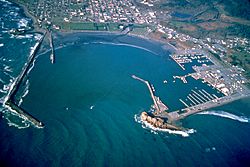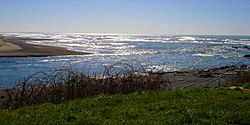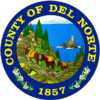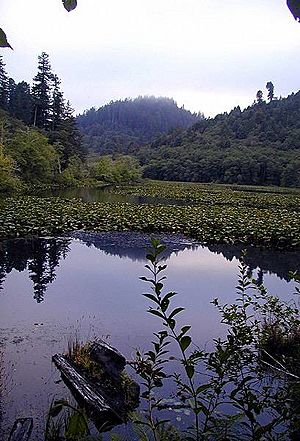Del Norte County, California facts for kids
Quick facts for kids
Del Norte County
|
||
|---|---|---|
| County of Del Norte | ||
|
Images, from top down, left to right: Crescent City Harbor, Redwood National Park, Castle Rock, the mouth of the Smith River
|
||
|
||

Location in the state of California
|
||
| Country | United States | |
| State | California
|
|
| Region | North Coast | |
| Incorporated | March 2, 1857 | |
| Named for | Its location, "Of the North" (Spanish: Del norte), in California | |
| County seat | Crescent City | |
| Largest city | Crescent City | |
| Government | ||
| • Type | Council–CAO | |
| Area | ||
| • Total | 1,230 sq mi (3,200 km2) | |
| • Land | 1,006 sq mi (2,610 km2) | |
| • Water | 223 sq mi (580 km2) | |
| Highest elevation | 6,415 ft (1,955 m) | |
| Population | ||
| • Total | 27,743 | |
| • Estimate
(2023)
|
26,589 |
|
| • Density | 22.56/sq mi (8.71/km2) | |
| GDP | ||
| • Total | $0.947 billion (2022) | |
| Time zone | UTC−8 (Pacific Time Zone) | |
| • Summer (DST) | UTC−7 (Pacific Daylight Time) | |
| Area codes | 707 | |
| FIPS code | 06-015 | |
| GNIS feature ID | 1682074 | |
| Congressional district | 2nd | |
Del Norte County is a county in the far northwest corner of California. It sits right on the Pacific Ocean, next to the Oregon border. The name "Del Norte" comes from Spanish and means "Of The North."
About 27,743 people lived here in 2020. The main city and county center is Crescent City. Many early settlers were Portuguese dairy farmers from the Azores. This might be why locals say the county name as "Del Nort" instead of "Del Nor-teh."
This rural county is famous for its huge Coast Redwood forests. Some of these trees are taller than 350 feet! Del Norte County also has unique plants, many types of coastal birds and fish, beautiful rocky beaches, and historic lighthouses.
Contents
History of Del Norte County
The land that is now Del Norte County has always been home to the Yurok and Tolowa Native American Nations.
Early Explorers and Settlement
The first European American to explore this area was Jedediah Smith in the early 1800s. He was the first to reach this distant land by walking overland. For him, it was like the "end of the land" where the American continent met the Pacific Ocean.
In 1855, a lighthouse was built at Battery Point, a small island near Crescent City. This lighthouse is still working today and is an important historical site.
County Establishment
Del Norte County was officially created in 1857. It was formed from a part of Klamath County. This happened after the big California Gold Rush. Klamath County itself no longer exists since 1874.
Geography of Del Norte County
Del Norte County covers about 1,230 square miles. Most of this area, about 1,006 square miles, is land. The rest, about 223 square miles, is water.
Mountains and Coastline
The county's landscape is mostly mountainous. It is dominated by the Coastal Range and the Klamath Mountains. The elevation changes a lot, from sea level up to over 6,400 feet high.
Even though much of the county has steep hills, there are flat areas. You can find these flat spots along the coast and in some mountain valleys. The county has 37 miles of coastline. A wide flat area along the coast is in the northwest part of the county.
Neighboring Areas
Del Norte County shares borders with these other counties:
- Curry County, Oregon - to the northwest
- Josephine County, Oregon - to the northeast
- Siskiyou County - to the east
- Humboldt County - to the south
Natural Attractions
Del Norte County is home to many beautiful natural spots.
Beaches
- Pelican State Beach
Recreation Areas
- Smith River National Recreation Area
Rivers
- Klamath River - one of the longest rivers in California.
- Smith River - known as a "crown jewel" for its beauty and protection.
Wildlife Refuges
- Castle Rock National Wildlife Refuge
Parks
- Del Norte Coast Redwoods State Park
- Jedediah Smith Redwoods State Park
- Redwood National Park
- Tolowa Dunes State Park
- Ruby Van Deventer County Park
- Florence Keller County Park
Ecology and Wildlife
Del Norte County has many different types of plants and animals. You can find various forests here, including mixed oak forests. Some unique trees, like the Blue oak and Black Oak, grow here. Douglas-fir trees are also common.
Population Facts
The population of Del Norte County was 27,743 people in 2020. This was a small decrease from 28,610 people in 2010.
| Historical population | |||
|---|---|---|---|
| Census | Pop. | %± | |
| 1860 | 1,993 | — | |
| 1870 | 2,022 | 1.5% | |
| 1880 | 2,584 | 27.8% | |
| 1890 | 2,592 | 0.3% | |
| 1900 | 2,408 | −7.1% | |
| 1910 | 2,417 | 0.4% | |
| 1920 | 2,759 | 14.1% | |
| 1930 | 4,739 | 71.8% | |
| 1940 | 4,745 | 0.1% | |
| 1950 | 8,078 | 70.2% | |
| 1960 | 17,771 | 120.0% | |
| 1970 | 14,580 | −18.0% | |
| 1980 | 18,217 | 24.9% | |
| 1990 | 23,460 | 28.8% | |
| 2000 | 27,507 | 17.3% | |
| 2010 | 28,610 | 4.0% | |
| 2020 | 27,743 | −3.0% | |
| 2023 (est.) | 26,589 | −7.1% | |
| U.S. Decennial Census 1790–1960 1900–1990 1990–2000 2010–2015 |
|||
Education in Del Norte County
Del Norte County has a branch campus of College of the Redwoods. This is a two-year college.
The county also has a special school system. The Del Norte County Unified School District manages all public schools. This includes schools from pre-Kindergarten up to twelfth grade.
Schools in the County
- The only high school is Del Norte High School. Their mascot is the Warrior.
- There are five elementary schools for grades K-5: Bess Maxwell, Joe Hamilton, Margaret Keating, Mary Peacock, and Pine Grove.
- Three elementary schools go from K-8: Mountain, Redwood, and Smith River.
- There is one middle school: Crescent Elk.
The County Office of Education also helps with special education. They offer other learning choices too. These include Community Day and juvenile detention programs. Alternative schools are Del Norte Community Day, Elk Creek detention center, and Sunset Continuation High School.
Del Norte County also has some private and charter schools.
Transportation
Getting around Del Norte County is possible through several ways.
Main Roads
 U.S. Route 101
U.S. Route 101 U.S. Route 199
U.S. Route 199 State Route 169
State Route 169 State Route 197
State Route 197
Public Transport
Redwood Coast Transit provides local public transportation. You can also connect to Amtrak train services through their bus routes.
Air Travel
Advanced Air offers passenger flights from Jack McNamara Field Airport. They have daily flights to Oakland International Airport and Los Angeles-Hawthorne Airport. These flights are supported by a special government grant.
Harbor
The Crescent City Harbor is a busy place. It is a commercial fishing port for many types of seafood. These include salmon, shrimp, tuna, cod, and Dungeness crab. Almost half of all Dungeness crab served in California restaurants comes from this harbor! The harbor also has other businesses and docks for pleasure boats.
Communities in Del Norte County
Crescent City is the main city and the county seat. It's the only official city in Del Norte County. Its population count includes people living at Pelican Bay State Prison, which is ten miles north of the city.
City
Census-designated places (CDPs)
- Bertsch–Oceanview
- Fort Dick
- Gasquet
- Hiouchi
- Klamath
- Smith River
- Crescent City North – a former CDP
Other Unincorporated Communities
- Adams Station
- Darlingtonia
- Klamath Glen
- Pacific Shores
- Requa
- Scaath
- Yontocket
Images for kids
See also
 In Spanish: Condado de Del Norte para niños
In Spanish: Condado de Del Norte para niños











